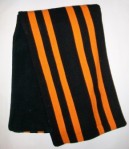In a recent poll of Speech and Language Pathologists (The #SLPeeps Top 10 SLP Gifts) held by the folks at LessonPix, the number one object of infinite desire was… the scarf! Talk about stereotypes fulfilled. Tragically, this Dude was one of those who voted for the scarf, and readily admits to having a small collection of the things (you have to match with your coats and jackets – duh!) so perhaps it’s not necessarily surprising.
Of course, the other factor that may be biasing the results is that the poll is taking place just as the weather is becoming peppered with snow and the temperatures are falling faster than Mitt Romney’s post-election popularity [1]. So the stores are currently filled with more scarves than Santa has elves.
And so speaking of scarves and elves…
One of the standard areas of concern for SLPs is teaching plurals. To be more accurate, teaching the phonological realizations of a morphological process that creates plural forms from a singular morpheme base. I toss that in because some folks seem to think that the Dudes are trivial, unprofessional, and simply out for a good time. That may have some veracity about it, but we are very aware that not everyone who reads this blog is, in fact, an SLP. So our role is to entertain and educate a broad church, and to promote the idea that SLPs are more than middle-class gentile ladies who wear scarves with twin-sets and pearls. Well, OK, so we do wear scarves…
Therapeutically speaking, we can use the scarf as a way of teaching a rather limited set of weird plural forms, namely those nouns that end in an /f/ sound when singular but turn into a /vz/ when plural. Here’s the list;
calf – calves
life – lives
thief – thieves
elf – elves
loaf – loaves
wife – wives
half – halves
self – selves
wolf – wolves
knife-knives
sheaf-sheaves
leaf – leaves
shelf – shelves
There are ongoing discussions about dwarf – dwarfs/dwarves, with linguists typically coming down on the side of dwarves but Disney still insisting on “Snow White and the Seven Dwarfs” – and you don’t mess with the Mouse unless you want a law suit in the mail [2].
Historically, these “irregular” plurals come from a “regular” source – Old English. You see, one of the common plurals in OE was the ending “-as,” and so you would talk about one wulf or wif (wolf and wife [3]) but two or more wulfas or wifas. But there was also a rule in existence that said that all fricatives (such as /f/ or /s/) would become voiced (change to /v/ or /z/) when they were stuffed between two other voiced sounds, which includes vowels. So seeing as the /f/ in wulfas and wifas sat between vowels, they were pronounced as /’wulvæz/ and /’waɪvæz/. Finally, over time, the final unstressed vowel was dropped leaving /’wulvz/ and /’waɪvz/.
Tada!!
But the fun doesn’t stop here, oh no! Just to keep the excitement going, the word scarf doesn’t come from the Old English and wasn’t around with the wolves, wives, elves, leaves, or sheaves, and didn’t make an appearance in the English lexicon until the middle of the 16th century. It’s not absolutely certain, but odds are that scarf comes from Old Northern French escarpe meaning “a sash” or “a sling for a wounded arm.” At that time, folks did talk about wearing scarfs but in the 18th century, it became mor fashionable to wear scarves, the plural swap being influenced by those old Old English “irregulars.”
Using my old friend, the Corpus of Historical American, I was able to produce the following graphs that show how scarfs declined as scarves ascended.
As a confirmatory check, I also did a Google N-gram search:
We could stop here and say “so that’s why you should teach scarves and not scarfs” and be done with it, but there’s just one more wonderful little quirk of English I’d like to point out.
“My dog is a hungry wee beastie. Whenever I give him some food, he scarfs it down as if he’d never eaten before.” So why doesn’t he *scarve it down?
Well, when the word scarf appears as a verb, it comes from a completely different place. It is, in fact, a variation of the word scoff, which is in turn a slang word for “to eat voraciously” or “to devour hungrily.” This word made its appearance at the beginning of the 19th century and so it’s subject to the rules of Modern English grammar, not Old English. When you add the third-person verb ending of “s” to scoff, it becomes plain old scoffs, and in Modern English, the final sound takes on the voicing of the preceding sound, hence /’skɒfs/.
So there you have it! SLPs love scarves because they remind us about phonological processes that change words over time, processes that changed the pronunciation of plural and verb morphology, and even about the history of the English language.
Or maybe we just like the colors…
Notes
[1] I’m not given to engaging in political discussions but yesterday I drove past a gas station here in Ohio where the price of a gallon was $2.98, and less than a month ago I was listening to Republican pundits prophesying how gas prices would rocket if Obama were elected. They were so sure, certain, positive, and adamant about the truth of the assertion that there are only two conclusions to draw from their pontificating; either there were wrong (in which case they are no smarter than anyone who can scrawl an “X” on a ballot so not worth listening to) or they were lying (in which case they are lying bastards and will be first against the wall when the revolution comes.) If there’s a third alternative, let me know.
[2] J.R.R. Tolkien, a linguistics scholar, argued for the use of dwarves, and all his works use that. But the venerable Oxford English Dictionary acknowledges the words dwarfs as a plural, thus queering the pitch even further. Way back in 1862, Ernest Adams wrote The Elements of the English Language and noted that the forms dwarf/dwarves seemed to be in free variation, but that “in modern English the form in f is preferred” (p.39).
[3] Before someone smacks me over the head with very heavy copies of Beowulf or Caedmon’s Hymn, I am aware that since Old English was first spoken, there has been a Great Vowel Shift that changed the pronunciation of many words. So in my example of /’waɪf/ should really have had the long “eee” vowel, /i/ and been /’wif/ if we’re going to be more accurate. However, whether the vowel is /aɪ/ or /i/, the rule that changed /f/ and /s/ to /v/ and /z/ would still have applied.








